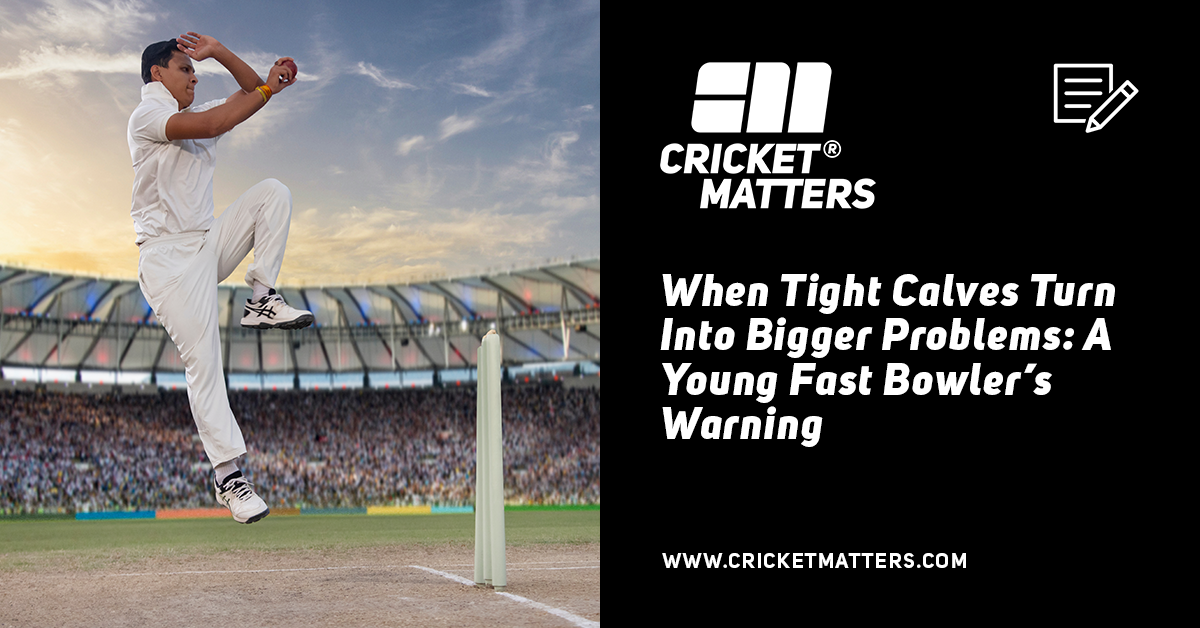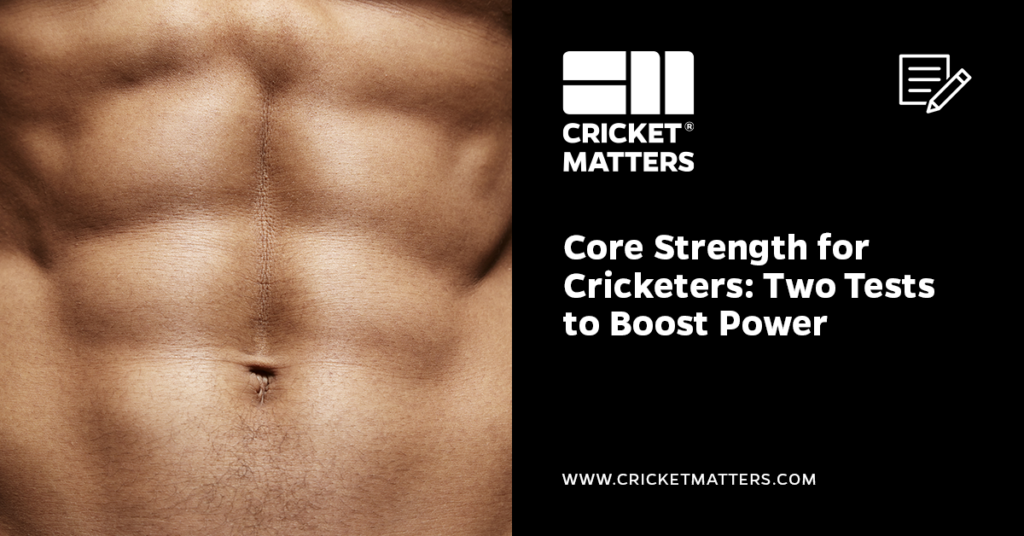
I hope you enjoy reading this blog post.
James Breese, Cricket Matters FounderIf you need my help with cricket coaching, strength and conditioning, injury rehab, or nutrition, click here.
Tight calves in fast bowlers are one of the most common — and overlooked — early warning signs in youth cricket.
A few weeks ago, ECB Level 4 Coach Ali Waldron asked me to assess one of his young fast bowlers. Thirteen years old. Six foot one. Still growing fast.
Ali wanted him screened before the off-season — a full movement and strength plan to support his development. A smart move. At that age, when a player hits a growth spurt, everything changes. They look strong, but their coordination, balance, and control can struggle to keep up.
He was a great kid — tall, athletic, focused. No injuries, no complaints, and nothing obvious to suggest a problem. But that’s often how it starts.
We ran the Functional Movement Screen (FMS) first, and that’s where things began to show. He could move well enough, but something looked off through the lower legs. Limited range. A subtle shift in how he landed and balanced. Nothing dramatic — but enough to warrant a closer look.
So, we moved to the Selective Functional Movement Assessment (SFMA) to break things down further. That’s when we found it. Both calves were incredibly tight. Ankles locked. Hardly any dorsiflexion, and almost no inversion or eversion. His lower legs were doing all the work his hips and feet couldn’t.
He didn’t feel pain — just stiffness when tested — but the pattern was clear. His body was adapting to rapid growth, building tension in the calves to stay stable while everything else tried to catch up.
And that’s the danger.
Tight calves in young bowlers rarely hurt at first — but they quietly change how a player moves. Over time, that lost ankle motion forces the stress upwards, into the knees, hips, and lower back.
This is the story of how it happens — and why parents and coaches need to spot the signs before a small restriction turns into a bigger problem.
Tight calves might seem harmless, but for young fast bowlers, they’re often the first domino in a chain of breakdowns that leads to knee, hip, or back pain.
Table of Contents
Why Tight Calves in Fast Bowlers Are a Red Flag for Young Players
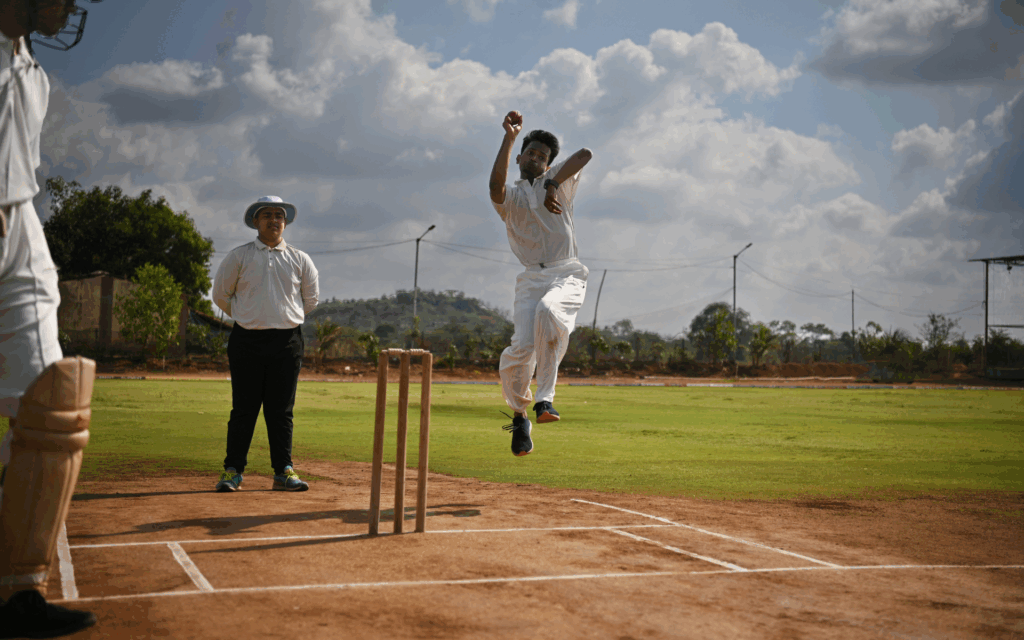
Fast bowling is one of the most demanding movements in sport. Every delivery sends huge forces through the front foot and ankle — far greater than most people realise. When that front leg plants, it has to stop your entire body moving forward while your upper body is still rotating at speed.
The ankle and calf are the first line of defence. They act like brakes and springs combined — absorbing impact, stabilising the foot, and then helping transfer energy up through the leg into the hips and torso.
But when those muscles tighten — the gastrocnemius, soleus, and peroneals — the ankle loses its ability to move and absorb shock. It can’t dorsiflex, it can’t roll, it can’t rotate. So the load doesn’t disappear; it simply moves.
The knee starts taking extra strain. The hips begin to twist out of sequence. The spine works harder to keep the body balanced. Over time, that’s when we see bowlers develop chronic knee pain, tight backs, or hip imbalances that never seem to go away.
Now add a growth spurt into the mix. Bones lengthen faster than muscles can adapt, leaving the calves constantly playing catch-up. What looks like normal stiffness is often the early warning sign — a signal that the lower limb can’t keep up with the rest of the body.
It’s a perfect storm for young fast bowlers: extreme forces, developing mechanics, and muscles struggling to adapt quickly enough to protect the system.
When a bowler’s ankle stops moving, the rest of the body starts compensating.
That’s where things really start to unravel.
When Tight Calves in Fast Bowlers Stop the Ankle from Moving — and the Front Leg from Bracing
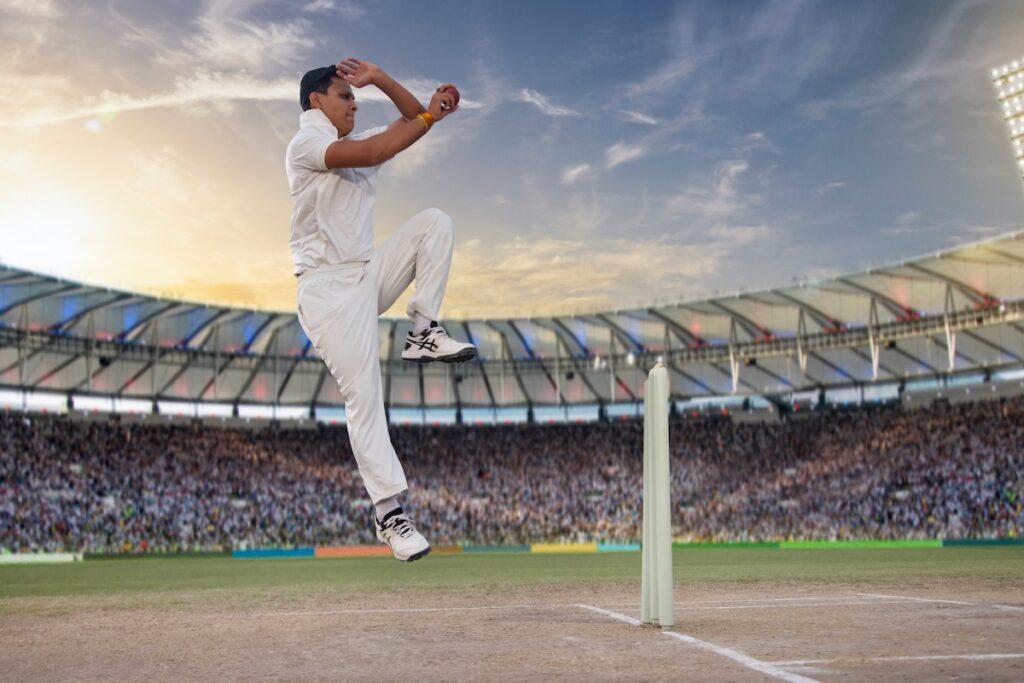
In fast bowling, the front leg is everything. It’s the anchor point — the moment your body transfers energy from the run-up into the delivery. Get that right, and the whole chain works smoothly. Get it wrong, and power leaks everywhere.
When we looked closer at this young bowler’s movement, that’s exactly what was happening. He couldn’t dorsiflex — meaning his ankle couldn’t bend forward enough when he landed. Instead of bracing through a stable front leg, his knee collapsed slightly, and his hips and trunk had to pick up the slack.
It didn’t hurt yet — but it was only a matter of time.
Biomechanics research from baseball pitching — which shares almost identical front-leg bracing mechanics with fast bowling — shows how crucial this is. Studies from Slowik (2024) and Diffendaffer (2023) found that when an athlete loses ankle dorsiflexion, they can’t extend or “brace” the front leg properly. That delay breaks the kinetic chain — velocity drops, trunk stability falters, and stress climbs into the lower back and shoulder.
In other words: when the front ankle can’t do its job, everything above it works harder.
The same pattern shows up in cricket. Tight calves limit dorsiflexion. Limited dorsiflexion means you can’t brace the front leg. Without that brace, the body can’t rotate around a firm base, so energy leaks upward — into the lumbar spine, hips, and shoulder.
That’s when you start hearing about back pain in young bowlers or niggles that won’t go away.
The cause often isn’t in the spine or shoulder — it starts at the ankle.
So while most parents and coaches worry about bowling actions, workloads, and back injuries, the first red flag is often sitting quietly below the knee — a pair of tight calves that have stopped doing their job.
The Chain Reaction — How Tight Calves in Fast Bowlers Affect the Whole Body
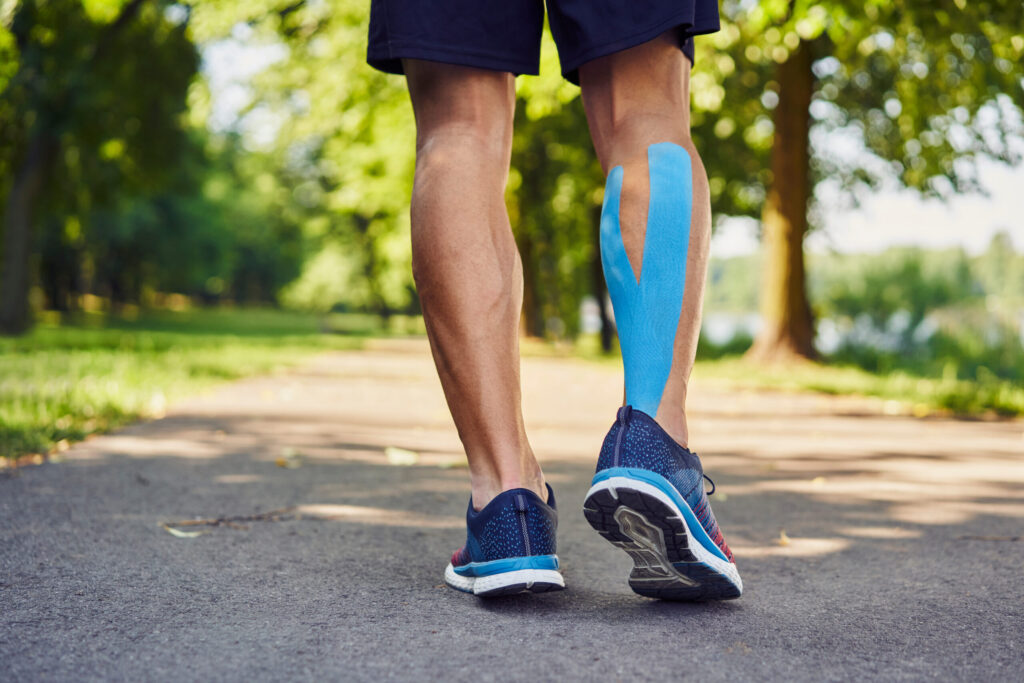
Cricket isn’t a straight-line sport. It’s rotational — a game built on spirals. Every delivery you bowl, every shot you play, is a symphony of rotation: feet anchoring, hips coiling, shoulders uncoiling. When that sequence is disrupted, everything up the chain feels it.
The first place it often goes wrong? The ankle.
In fast bowling, ground reaction forces through the front foot are enormous — among the highest recorded in any sport (Elliott, 2002; Portus et al., 2004). The ankle and calf complex act as the body’s shock absorbers, brakes, and springs all at once. When those tissues tighten, they don’t just lose flexibility — they lose their ability to rotate and absorb force.
That single restriction changes everything. The tibia stops rotating. The hip loses range. The lumbar spine begins to perform a job it was never designed for — creating motion instead of controlling it.
Biomechanist William Kibler described this perfectly in his 2012 work on the kinetic chain: when one joint stiffens, another compensates. Thomas Myers (2014) mapped it even further through the body’s spiral lines — fascial pathways that link the foot, calf, hamstrings, and spine into one continuous chain. When the ankle locks, those spirals tighten, redirecting force into joints that can’t handle it.
It’s the same pattern seen in baseball pitching research, where the front leg bracing mechanics mirror those of fast bowling. Studies by Slowik (2024) and Diffendaffer (2023) show that limited dorsiflexion prevents pitchers from fully extending and bracing the front leg — reducing force transfer and increasing trunk and shoulder stress. In simple terms: when the ankle can’t load, the spine pays for it.
And the evidence isn’t theoretical. I’ve seen it countless times in clinic. Knees that ache after bowling. Groins that tighten halfway through a spell. Low backs that feel “jammed” after every match.
It’s not coincidence — it’s compensation. The body’s doing precisely what it’s designed to do: find movement wherever it can.
That’s why a tight calf isn’t a minor issue for a young bowler. It’s the first domino. Once the ankle stops moving, the chain above it begins to adapt — quietly, repeatedly, until the pattern breaks down completely.
Why It’s Worse During Growth Spurts

For parents and coaches, this is where things get tricky.
During adolescence, the body doesn’t grow evenly. Bones grow first. Muscles, tendons, and fascia take their time to catch up. For a while, everything’s out of sync — long levers, short soft tissue, and a nervous system trying to make sense of it all.
It’s one of the most vulnerable windows in a young athlete’s development. The calves, hamstrings, and quads tighten because they simply can’t keep pace with how fast the skeleton is changing. Research by Stretch (2003) and Johnson (2014) both found the same thing: in young cricketers, that period of rapid growth is when most soft-tissue problems begin.
For fast bowlers, the timing couldn’t be worse.
When the lower leg can’t adapt, ankle mobility drops. The stride shortens. The hip and spine take over the workload. What should be a fluid, rotational movement becomes stiff and jarring — power leaks everywhere, and the body starts absorbing forces it was meant to redirect.
Now add the demands of modern coaching. More training sessions. More overs. Earlier technical development. The push for pace before the body’s ready for it. Suddenly, those few millimetres of lost ankle motion don’t sound so small.
Because in a sport built on repetition, those millimetres compound — delivery after delivery, session after session. It’s the difference between efficiency and overload.
And most of the time, you won’t see it coming until it’s too late.
What Parents and Coaches Should Watch For

You can spot the early warning signs long before they become injuries — if you know what to look for.
It’s rarely dramatic. A young bowler might start losing rhythm. The run-up looks stiffer. The front leg doesn’t brace as cleanly. The follow-through shortens. They might not say anything hurts — but something looks off.
Listen for phrases like “my calves always feel tight” or “I just can’t get through my action.” That’s usually the first clue.
From there, watch how they move. Can they sit into a full deep squat, feet together, heels down, without their body folding forward?
If not, it’s a strong indicator that their calves and ankles are doing too much of the work — and that restriction is already starting to travel up the chain.
The same goes for those subtle, persistent niggles:
- Groins that tighten mid-spell.
- Hamstrings that never feel loose.
- Backs that “jam up” after bowling or fielding.
And here’s the pattern I see over and over again — it’s almost textbook.
A young player shoots up in height. A few months later, they start feeling stiff. The rhythm in their bowling looks “off”. Everyone blames “technique,” but the real issue is below the knee.
So here’s the rule of thumb:
If your kid’s rhythm disappears, check their feet before their action.
Because in most cases, the problem isn’t how they move — it’s what’s stopping them from moving properly.
What We Did — Releasing the Chain

Once we identified the restriction in our young athlete, the goal wasn’t just to loosen the calves — it was to reset the entire chain.
We started where the system was clearly stuck: the lower leg. Using the RAIL framework— Release, Activate, Integrate, Load — we built a structured plan around how the body actually works, not just where it hurts.
Release:
We began with soft-tissue work on the quads, anterior tibialis, and peroneus longus — the areas gripping hardest just to stabilise him. From there, we worked down into the gastroc, soleus, and Achilles, and back up through the biceps femoris and glutes.
Each of these muscles feeds into the same myofascial chain — the Superficial Back Line and Spiral Line described by Myers (2014). When one link tightens, the whole system locks down.
Activate:
Once the tissue released, we focused on breathing and foot stability drills to teach the nervous system how to use the new range safely. Without this step, tension would’ve returned within days.
Integrate:
Next came hip mobility and rotational patterning — retraining how his hips, trunk, and shoulders coordinated with the now-mobile lower leg. The goal was simple: make the new movement automatic, not forced.
Load:
Finally, we reintroduced functional load — single-leg balance, hopping, and modified bowling drills — to reinforce the new pattern under real forces.
Within a few sessions, everything started to shift. His gait opened up. His run up smoothed out. He moved like an athlete again — tall, balanced, and powerful.
He wasn’t injured. Far from it. But he was right on that edge we talk about — not broken, not balanced, but breaking. The signs were subtle: tight calves, stiff ankles, small compensations that most people would miss. Yet those are exactly the moments that decide whether a young player continues to develop or starts to break down.
By freeing the lower legs and reconnecting the chain, we helped his body remember how to move — not just through drills, but through awareness. We didn’t fix a problem. We stopped one before it started.
Because it’s never one muscle or one joint — it’s the whole system. And sometimes, all it takes to keep it working is knowing where to start.
How to Keep Tight Calves from Coming Back

The key to keeping tight calves from turning into bigger problems isn’t more training — it’s education. Understanding how the body works, how it feels, and how to look after it during growth is what makes the real difference.
For most young cricketers, it starts with awareness.
You can’t fix what you can’t feel. Tight calves often creep in quietly. They don’t hurt; they start limiting the body’s freedom of movement. The challenge is that most kids — and parents — don’t notice until the pattern’s already set.
Movement is everything in cricket. When the ankles stop moving, the body has no choice but to find motion elsewhere — and that’s where injuries hide.
That’s why learning the basics matters. How to foam roll. How to stretch. How to move with control. It’s not complicated — it just needs consistency. A few minutes spent each week working on the calves, peroneals, and front of the shins can keep the lower legs supple and ready to handle the demands of fast bowling.
It’s also why regular sports massage can make such a difference, especially during growth spurts. It’s not a luxury — it’s maintenance. A skilled therapist can identify tension patterns early, release what’s holding them back, and help a young athlete maintain optimal movement throughout every stage of development.
The same goes for breathing. Most young players hold their breath without realising it. Teaching them to breathe deeply, relax, and let movement flow through the system resets more than just muscle tension — it calms the entire nervous system.
Then comes strength. Not heavy weights or endless repetitions, but simple, controlled exercises that build balance and resilience — calf raises, single-leg holds, light hops, and rotational warm-ups. The goal isn’t just to get stronger; it’s to help the body coordinate again.
Because when kids grow, everything’s changing — bones, tendons, posture, balance. The body needs time and guidance to regain its rhythm. And that rhythm only returns when tension is managed and movement is restored.
If you’re a parent or coach, this is where authentic coaching takes place — not just on the field, but in helping young athletes understand their bodies. Teach them to notice. To move. To take care of themselves before pain becomes the teacher.
It’s not about chasing perfection. It’s about staying balanced, aware, and ready for whatever comes next.
Final Word — Don’t Ignore the Early Signs

Tight calves might seem harmless — just another part of growing, training, or playing — but for a young fast bowler, they’re often the body’s first warning sign.
When the ankles stop moving freely, the chain reaction begins.
The knee works harder. The hip twists out of sync. The spine takes the load that should have been absorbed below. What starts as stiffness soon becomes a pattern — one that steals rhythm, reduces pace, and increases the risk of injury long before pain ever appears.
Movement is everything in cricket. It’s what makes a bowler efficient, an athlete balanced, and a performer consistent. When that movement becomes restricted — even slightly — technique starts to break down. Stride length shortens. The front leg can’t brace properly. Power leaks away. And suddenly, a player who once looked effortless begins to look like they’re fighting their own body.
That’s why early intervention matters. Not because every young cricketer is injured, but because every growing athlete is adapting. Catching tightness before it becomes restriction is the difference between staying athletic — and spending a season managing niggles that could have been avoided.
At Cricket Matters, we start from the ground up.
We look at how each link in the chain moves — from the feet and ankles to the hips, spine, and shoulders — to understand the full picture of performance. Our goal isn’t just to keep young athletes pain-free; it’s to help them move, bowl, and perform at their best, year after year.
If you’re a parent or coach who’s noticed the signs — tight calves, reduced rhythm, stiffness through the run-up — now’s the time to act. Book a Performance Analysis and find out what your child’s movement is really telling you.
It’s the first step toward long-term athleticism, healthy development, and bowling that looks — and feels — effortless.
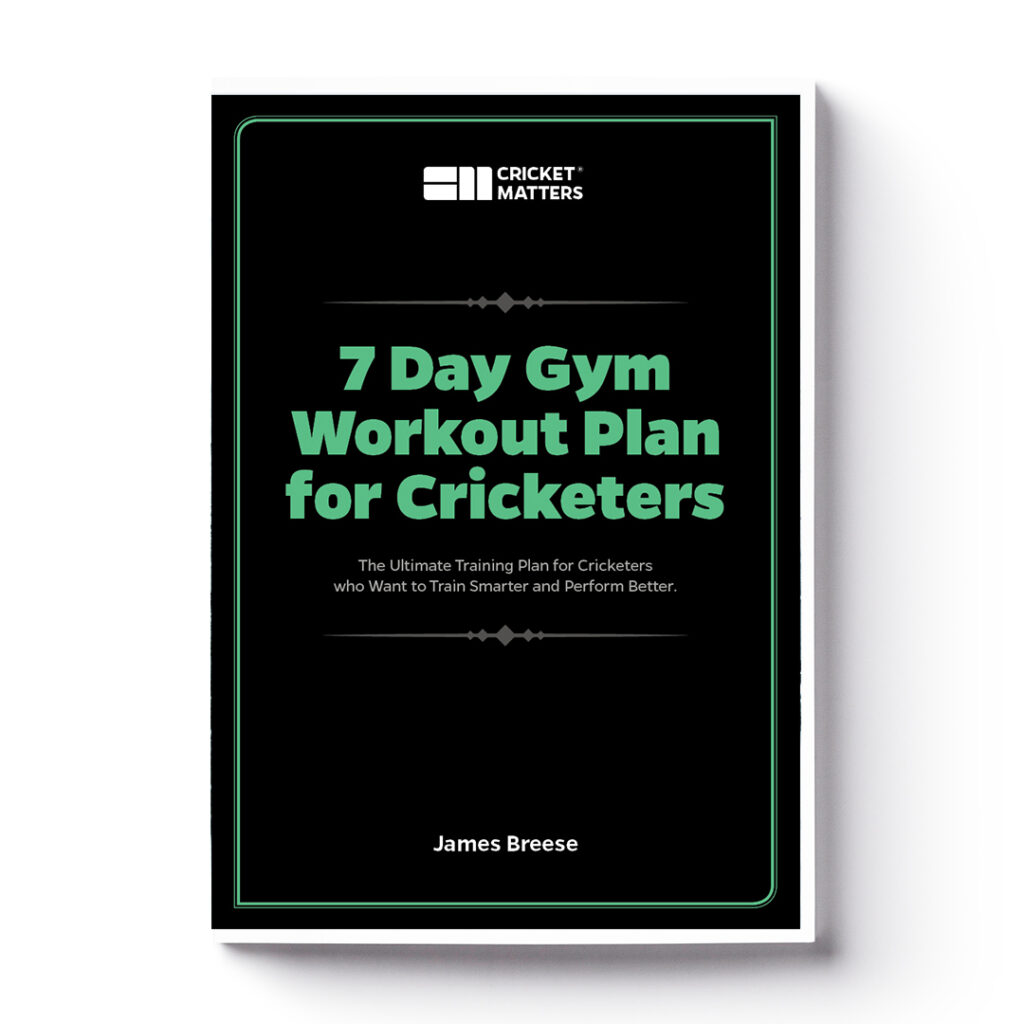
Have You Downloaded Our FREE 7-Day Gym Workout Plan?
Grab your complete step-by-step 7-day gym workout plan for cricketers today. There will be no more Guesswork. Just follow the plan and get results.
Evidence Corner: What the Research Says
Tight calves and limited ankle mobility aren’t just minor flexibility issues — they fundamentally change how young fast bowlers absorb force, brace the front leg, and transfer energy. Research across cricket, baseball, and youth athletic development all point to the same pattern: when dorsiflexion is lost, efficiency drops and injury risk rises up the chain.
What It Does Well
- Fast bowling and front-foot loading create extreme lower-limb stress: Biomechanical studies show that ground reaction and torsional forces through the front leg during delivery are among the highest in sport (Elliott, 2002; Portus et al., 2004). These loads demand full ankle mobility and calf elasticity for safe deceleration and energy transfer.
- Limited dorsiflexion reduces front-leg bracing and energy transfer: Baseball research — which mirrors cricket’s front-leg mechanics — confirms that reduced dorsiflexion prevents proper front-leg extension, leading to energy leaks, reduced velocity, and increased trunk and shoulder stress (Slowik, 2024; Diffendaffer, 2023; Crotin & Ramsey, 2023).
- Tight calves and ankle stiffness are linked to knee and back pain: Restricted dorsiflexion shifts impact absorption upward, increasing strain on the knees and lumbar spine (Malliaras, 2006; Backman & Danielson, 2011; Powden et al., 2015).
- Growth spurts amplify soft-tissue tightness and imbalance: Research in junior cricketers shows that during rapid skeletal growth, muscles and fascia lag behind, increasing tension and movement restriction in the lower limb (Stretch, 2003; Johnson et al., 2014).
- Fascial and kinetic chain connections explain why tight calves affect the spine: Myofascial research demonstrates continuous force transmission through the Superficial Back Line and Spiral Line — linking the feet, calves, hamstrings, and spine as one chain (Myers, 2014; Wilke et al., 2016; Kibler et al., 2012).
Where It Falls Short
- Limited cricket-specific research on youth mobility: While the biomechanics of fast bowling are well-studied, few papers directly examine ankle stiffness or dorsiflexion in junior players, meaning current evidence relies on comparable sports models.
- Individual variability: Not all restricted dorsiflexion leads to pain, but across large athlete populations, reduced mobility consistently predicts compensation higher up the chain.
- Prevention programs underused: Despite strong evidence for screening and mobility interventions, few grassroots cricket programs systematically assess ankle range or calf flexibility.
What This Means for Cricketers
For young fast bowlers, tight calves aren’t just about comfort — they’re about control. When the ankle loses mobility, the body finds rotation elsewhere: in the knees, hips, or lower back. The result is compensation, not power.
Early assessment and targeted mobility work protect developing athletes before small restrictions become chronic problems. Structured frameworks like FMS and SFMA, combined with myofascial release and load retraining, restore efficiency, rhythm, and injury resilience.
Key Research References
- Elliott, B. (2002). Fast Bowling in Cricket: Biomechanical Factors and Injury Implications. Sports Medicine, 32(10), 761–775.
- Portus, M. R., et al. (2004). Fast Bowling Biomechanics and Injury Risk Factors. Journal of Sports Sciences, 22(8), 707–721.
- Slowik, J. S., Diffendaffer, A. Z., & Crotin, R. L. (2024). Biomechanical Effects of Foot Placement During Pitching. Sports Biomechanics.
- Diffendaffer, A. Z., Bagwell, M. S., & Fleisig, G. S. (2023). The Clinician’s Guide to Baseball Pitching Biomechanics. Sports Health, 15(1), 46–58.
- Crotin, R. L., & Ramsey, D. K. (2023). Impact of Fatigue-Induced Stride Length Compensations on Ankle Biomechanics. Life, 13(4), 986.
- Malliaras, P., Cook, J. L., & Kent, P. (2006). Reduced Ankle Dorsiflexion Increases Risk of Patellar Tendinopathy in Athletes. British Journal of Sports Medicine, 40(9), 738–743.
- Backman, L. J., & Danielson, P. (2011). Low Range of Ankle Dorsiflexion as a Risk Factor for Patellar Tendinopathy in Junior Athletes. American Journal of Sports Medicine, 39(12), 2626–2633.
- Powden, C. J., et al. (2015). Reduced Ankle Dorsiflexion and Injury Risk: A Systematic Review. Journal of Athletic Training, 50(4), 403–410.
- Stretch, R. A. (2003). Injury Patterns in Schoolboy and Junior Cricketers. South African Journal of Sports Medicine, 15(2), 37–40.
- Johnson, M. I., et al. (2014). Growth-Related Muscle Tightness and Overuse Injuries in Youth Athletes. Pediatric Exercise Science, 26(3), 324–331.
- Kibler, W. B., Press, J., & Sciascia, A. (2012). The Kinetic Chain in Sports Rehabilitation. Journal of Strength and Conditioning Research, 26(2), 572–580.
- Myers, T. W. (2014). Anatomy Trains: Myofascial Meridians for Manual and Movement Therapists (3rd ed.). Elsevier.
- Wilke, J., Krause, F., & Vogt, L. (2016). What Is Evidence-Based About Myofascial Chains? Journal of Bodywork and Movement Therapies, 20(3), 530–541.
Bottom Line for Cricketers
Tight calves in young fast bowlers aren’t harmless — they’re the first link in a chain of compensations. When the ankle stops moving, the body absorbs force where it shouldn’t. Catch it early, restore mobility, and you don’t just prevent injury — you protect rhythm, power, and longevity.
FAQ
Why Tight Calves Are a Concern for Young Fast Bowlers
Tight calves in young bowlers can restrict ankle mobility, particularly dorsiflexion — the forward bending of the ankle joint. This limitation affects how the front leg absorbs and transfers force during the bowling action. When the ankle can’t move freely, the load shifts upwards through the kinetic chain to the knee, hip, and lower back. Over time, this may impact bowling mechanics and raise the risk of overuse injuries. Studies in both cricket and similar throwing sports (Elliott, 2002; Portus et al., 2004; Kibler, 2012) indicate that reduced ankle mobility changes how energy is transferred throughout the body, often leading to compensations higher up the kinetic chain.
What Causes Tight Calves in Young Cricketers
During adolescence, bones grow more quickly than muscles and tendons can adapt — a period known as peak height velocity. This temporary imbalance can cause muscle tightness, especially in the calves, hamstrings, and quadriceps (Stretch, 2003; Johnson, 2014).
For fast bowlers, repetitive loading through the lower legs worsens this natural tightness. Landing forces, sprinting, and bracing on the same front leg can lead to the gastrocnemius, soleus, and peroneal muscles shortening and stiffening over time. This is part of the normal adaptation process for growing athletes, but without adequate mobility or recovery, it can result in movement restrictions.
How Tight Calves Affect Bowling Mechanics and Cricket Performance
The calf and ankle serve as shock absorbers during front-foot impact. Limited dorsiflexion decreases this ability, forcing the body to seek stability elsewhere. In fast bowling, this may lead to less effective front-leg bracing — a crucial element in energy transfer and ball velocity.
Research on similar high-velocity throwing actions, such as baseball pitching (Diffendaffer et al., 2023; Slowik et al., 2024), indicates that restricted ankle mobility can disrupt timing between the lower and upper body, increasing strain on the spine and shoulders. In cricket, similar compensations are observed when bowlers develop tight calves and diminished ankle range.
What Parents and Coaches Should Watch for in Young Cricketers
Early signs of calf tightness in young bowlers often manifest as subtle changes in movement rather than pain. You might observe reduced rhythm or stiffness in the bowling action, a shorter stride, or a front leg that appears to collapse slightly at delivery. Sometimes the bowler struggles to bend the ankle properly during landing or follow-through, or they begin experiencing persistent tightness in the groin, hamstrings, or lower back without an apparent cause. A simple method to screen for this is by asking the player to perform a deep squat with their heels on the ground. If they cannot do it comfortably, it may indicate restricted calf length or limited ankle mobility. Identifying these patterns early enables parents and coaches to address developing issues before they develop into more serious injuries.
How Tight Calves Can Be Managed and Prevented in Cricketers
Managing calf tightness involves a combination of mobility, strength, and recovery strategies. Self-release techniques (foam rolling or massage), gentle stretching, and eccentric calf exercises help maintain tissue elasticity. Breathing drills and balance training can also improve coordination and reduce overall muscle tension. Regular movement assessments — whether by coaches, physiotherapists, or strength professionals — are valuable for identifying early restrictions. During growth phases, gradual workload progression and adequate rest are equally important. The goal is not to eliminate tightness entirely but to ensure that mobility and strength remain balanced so the athlete can continue developing safely.

